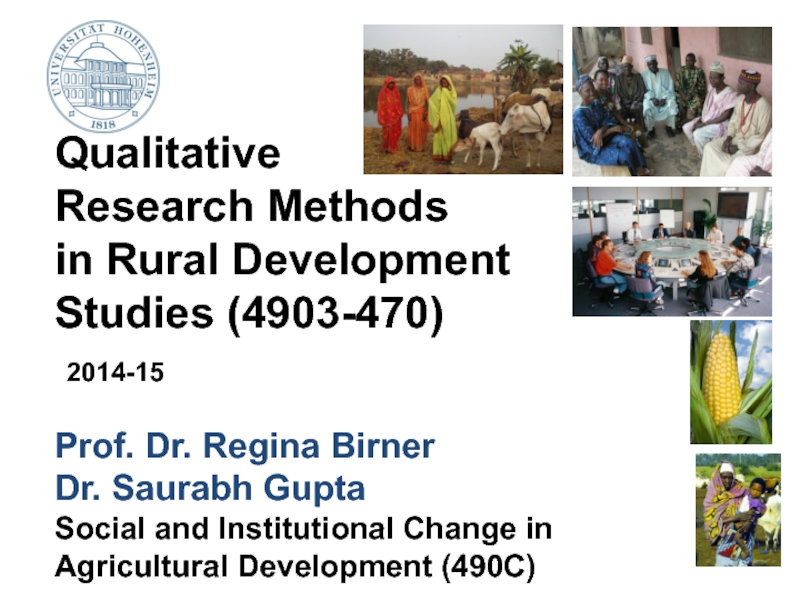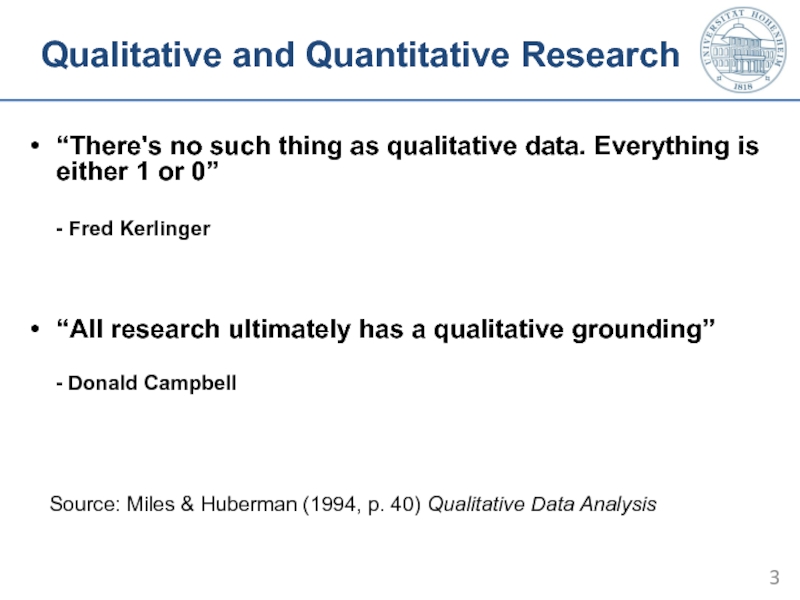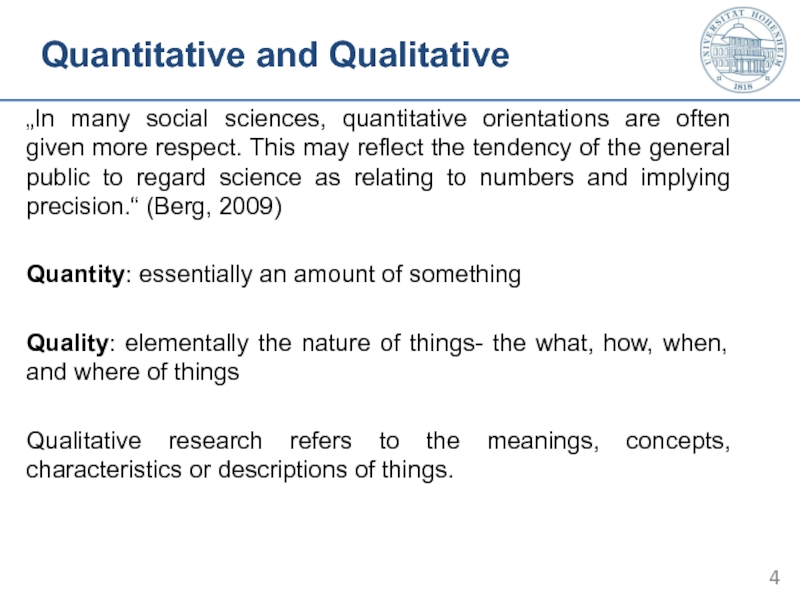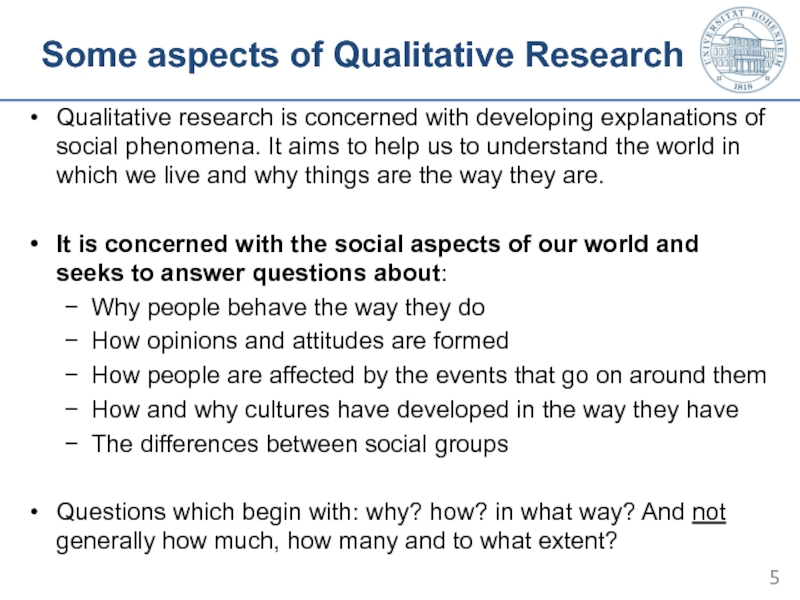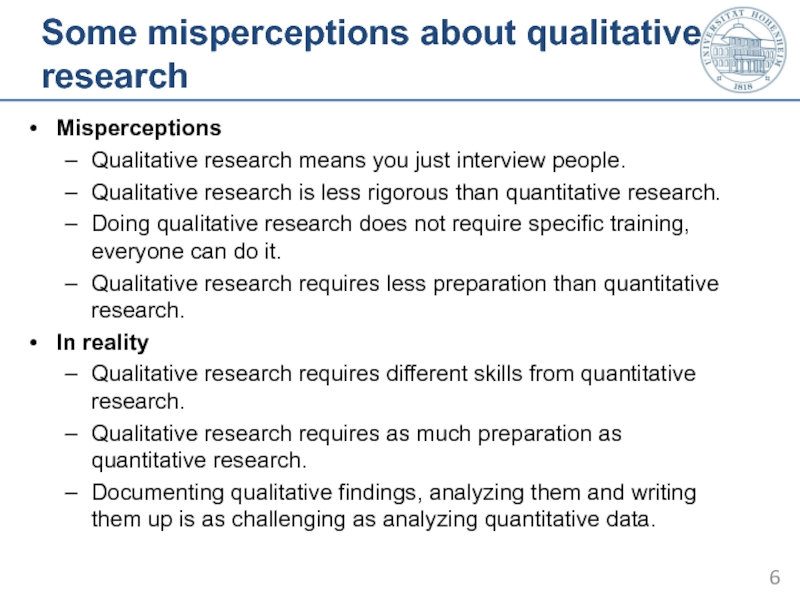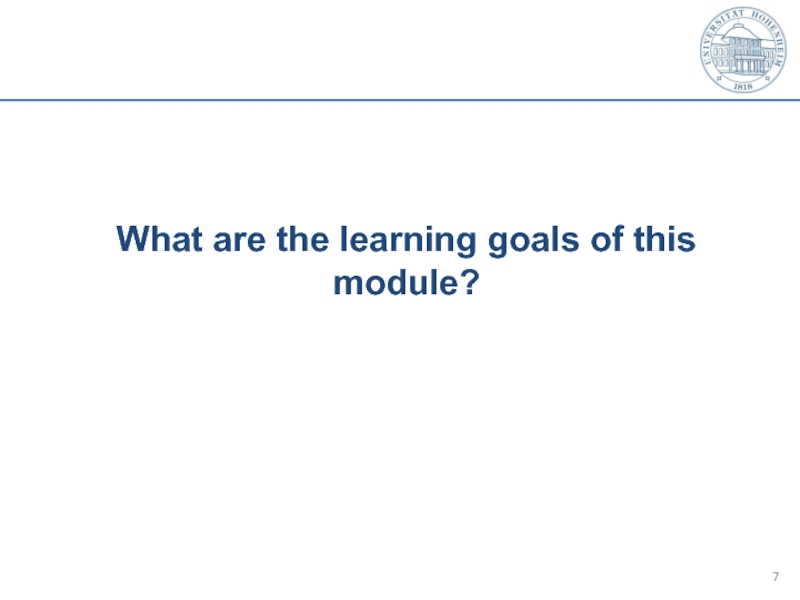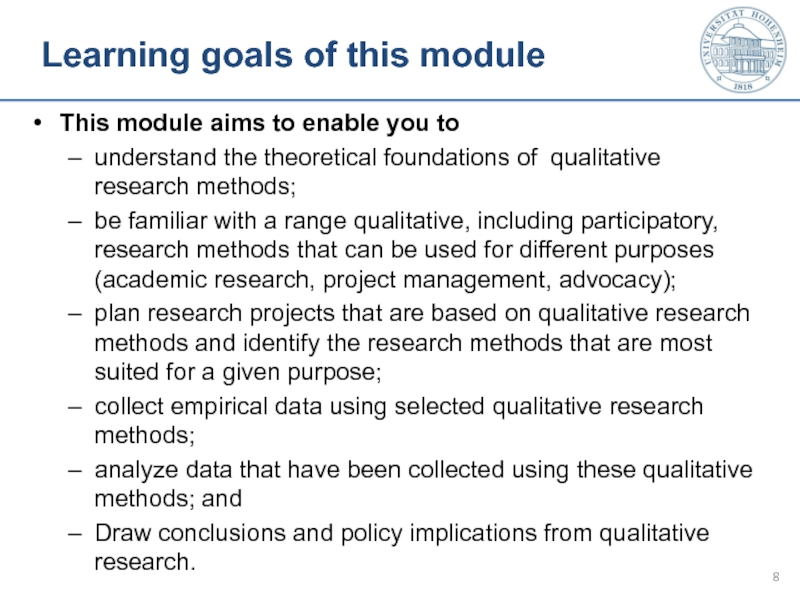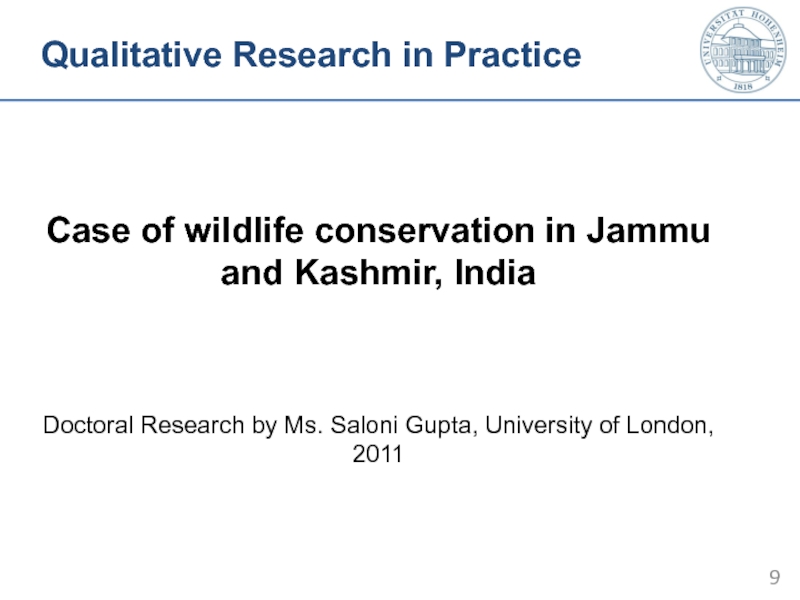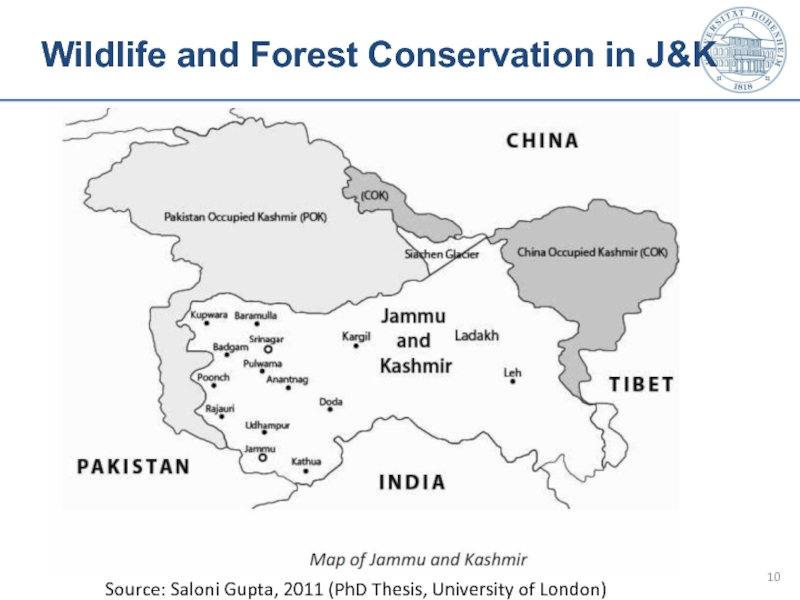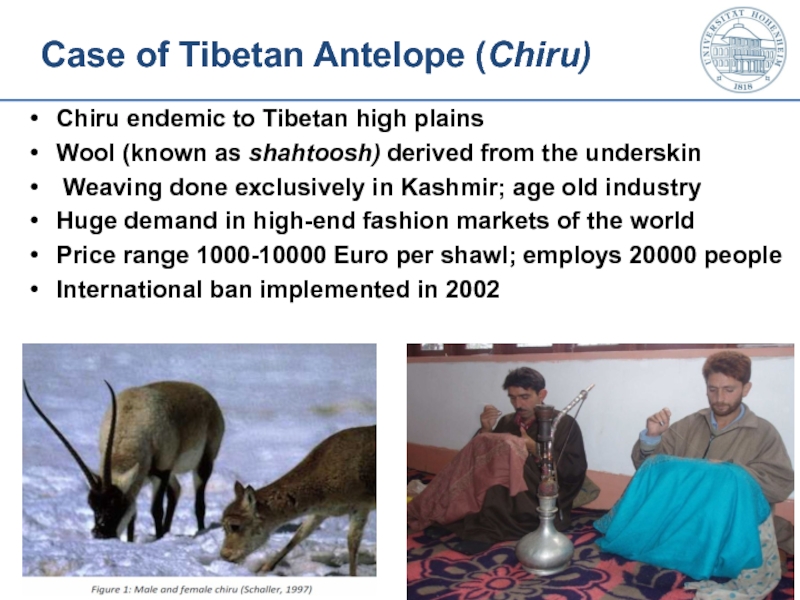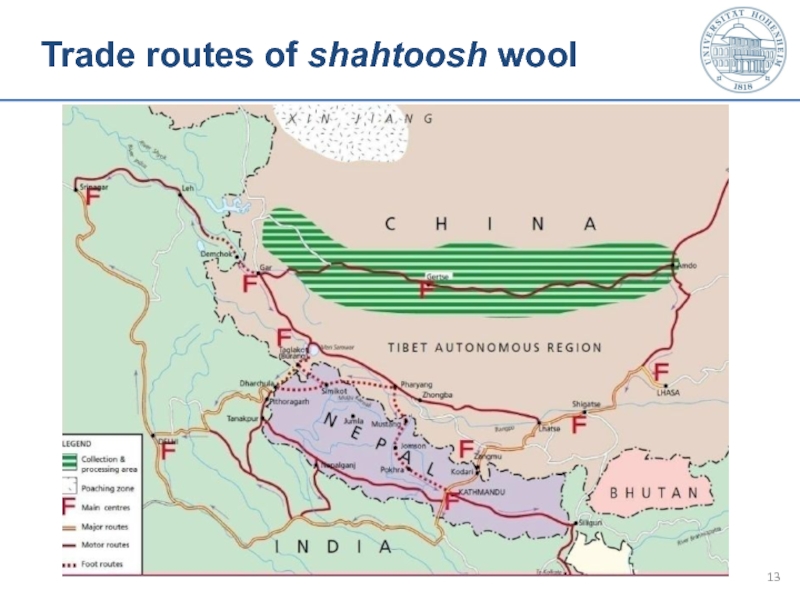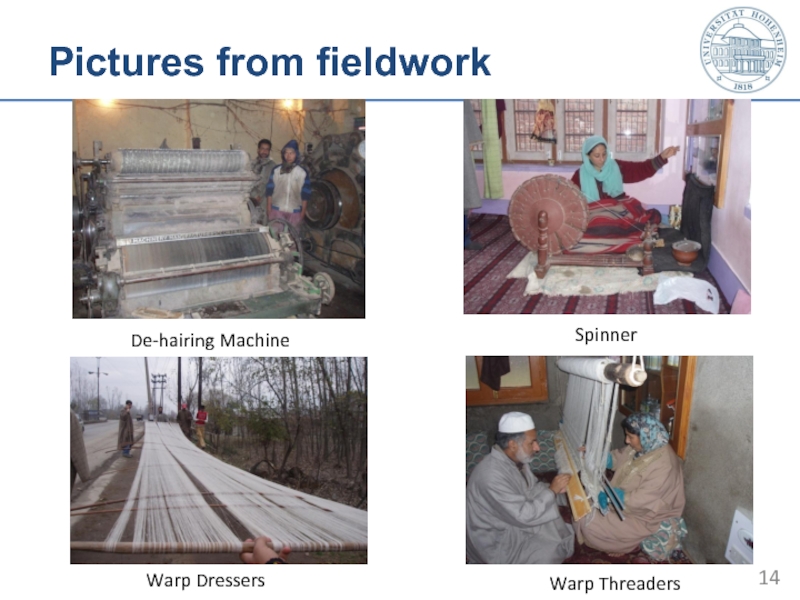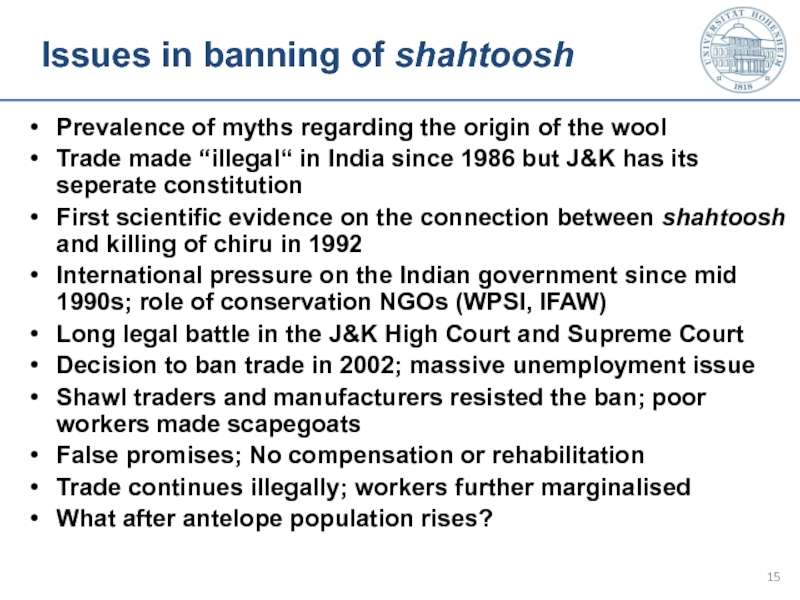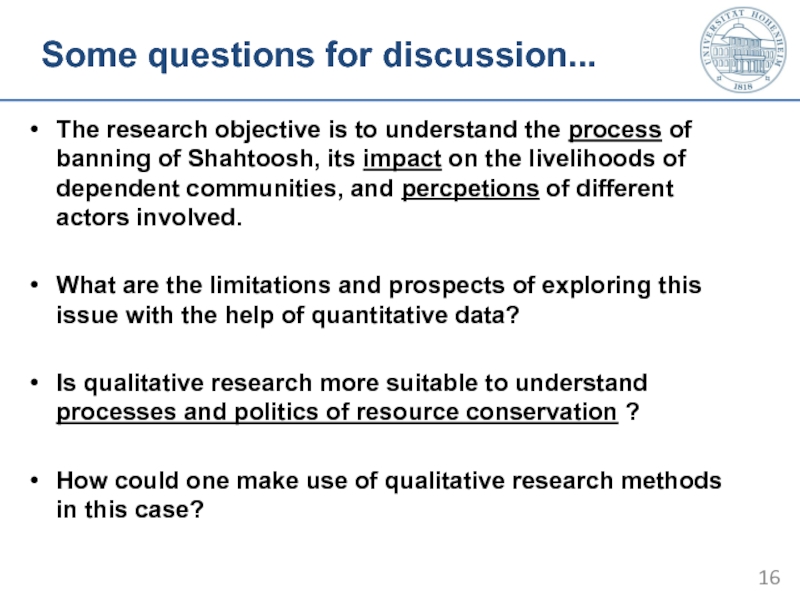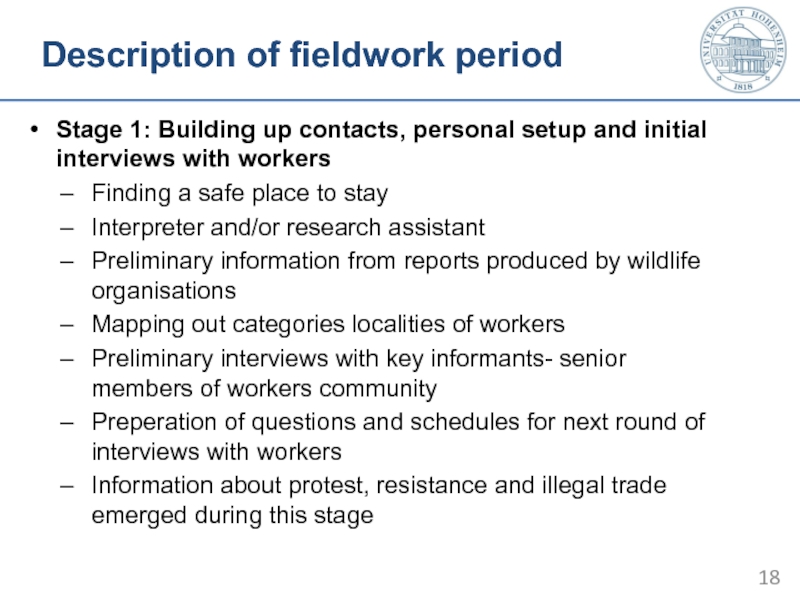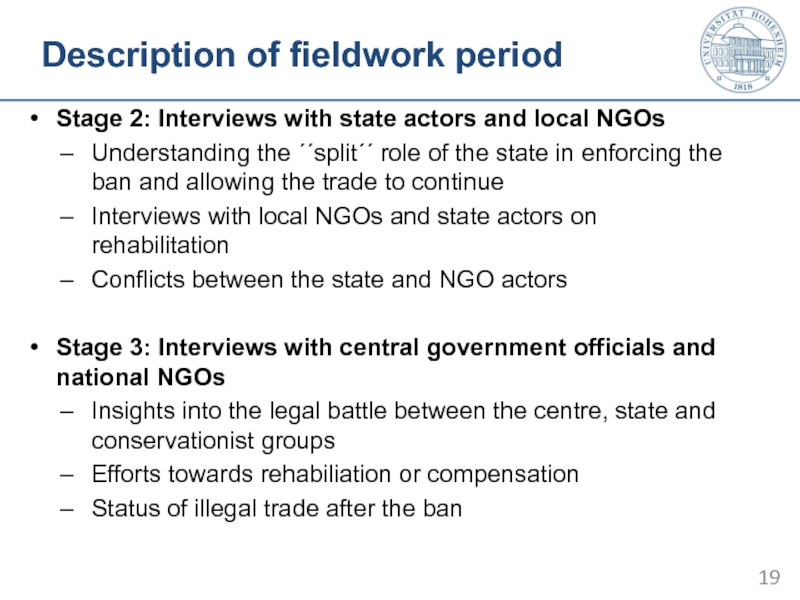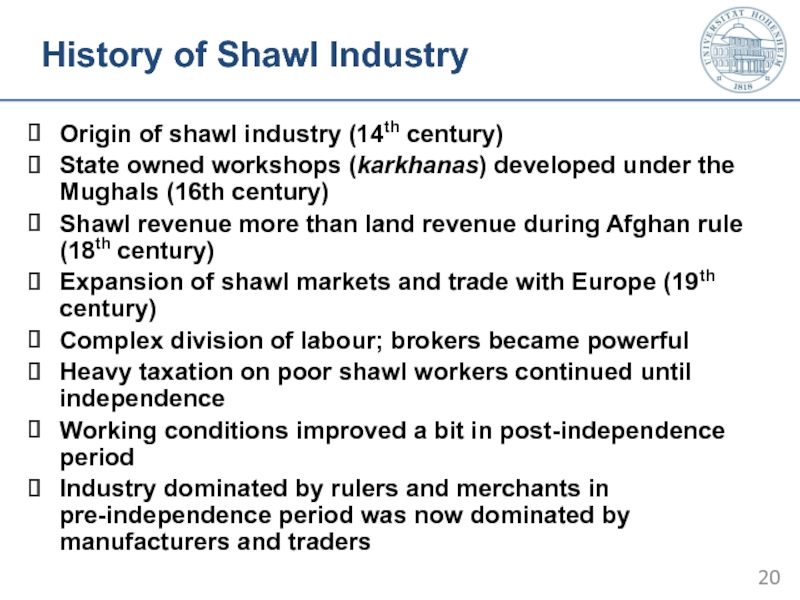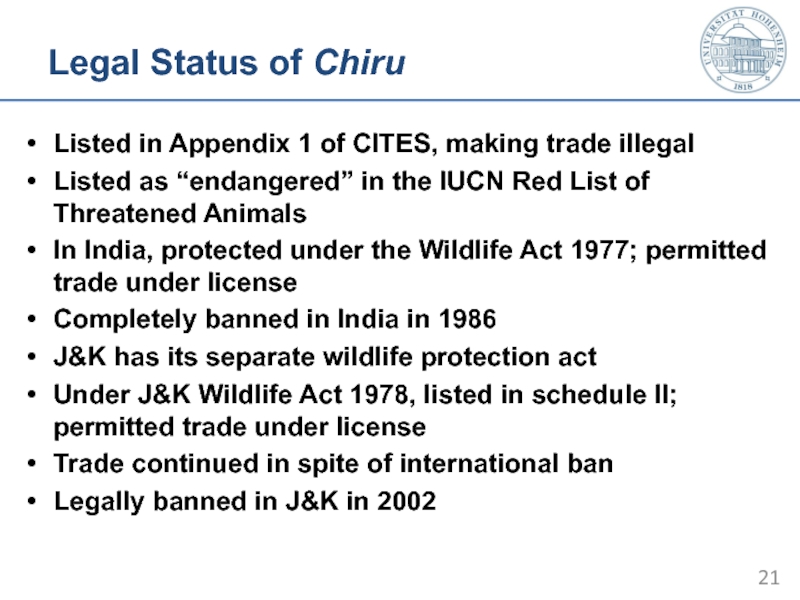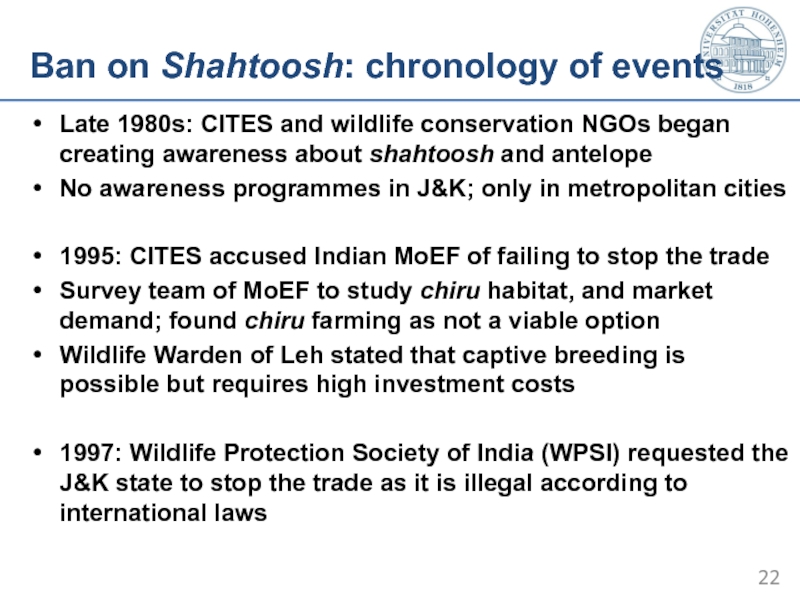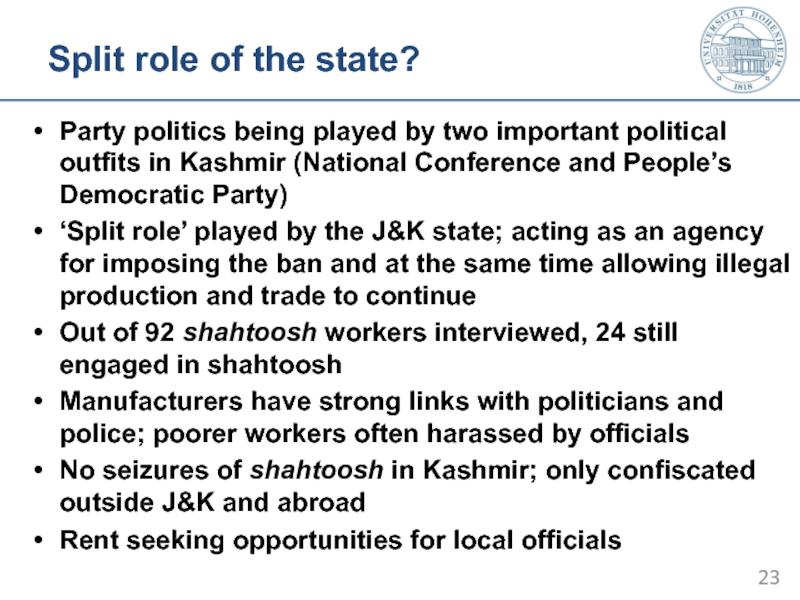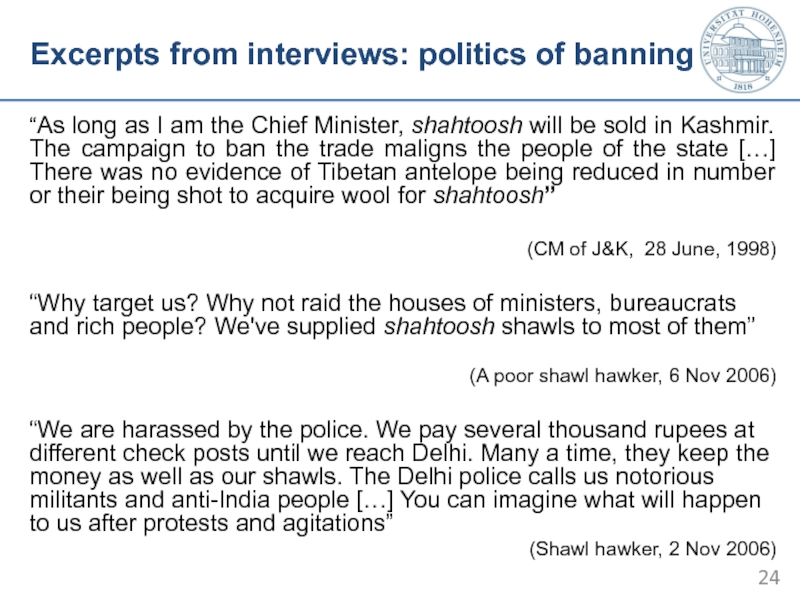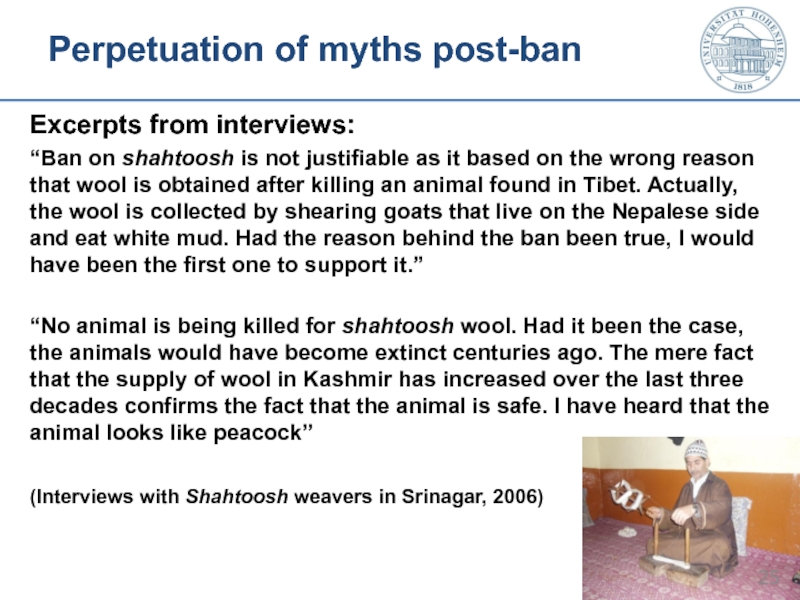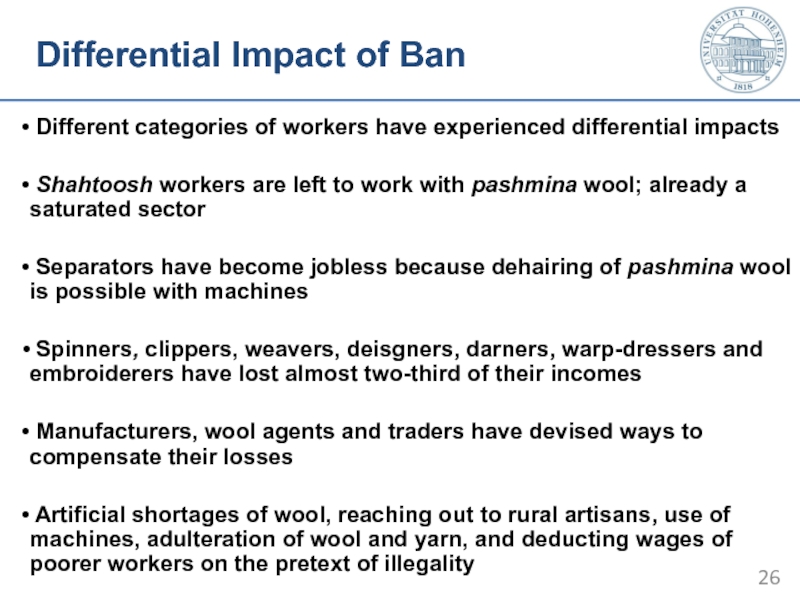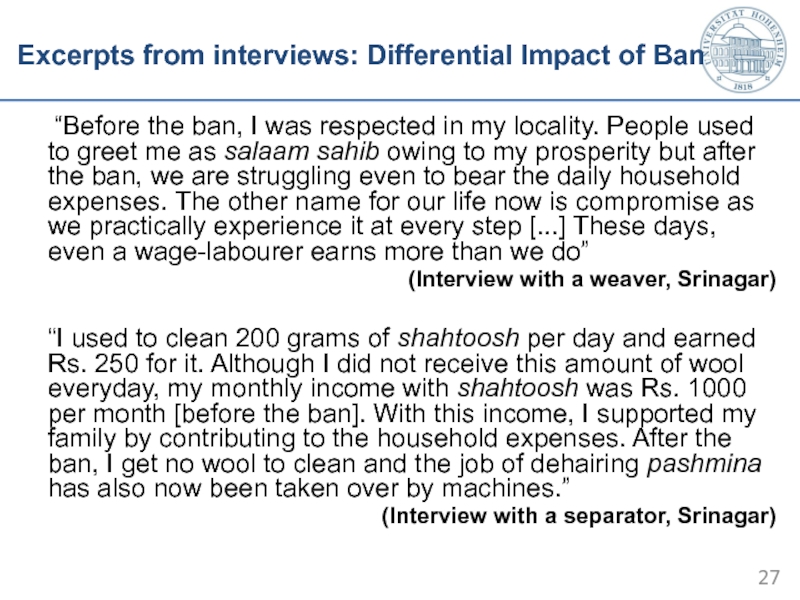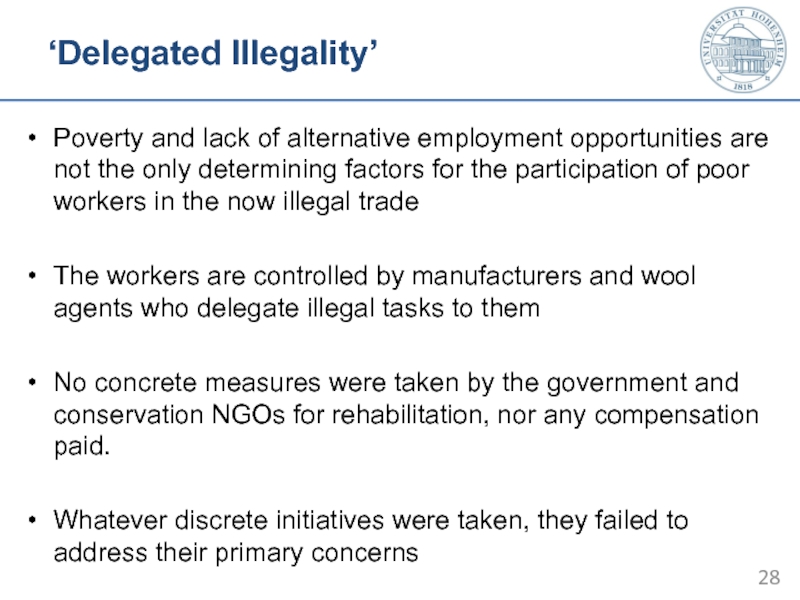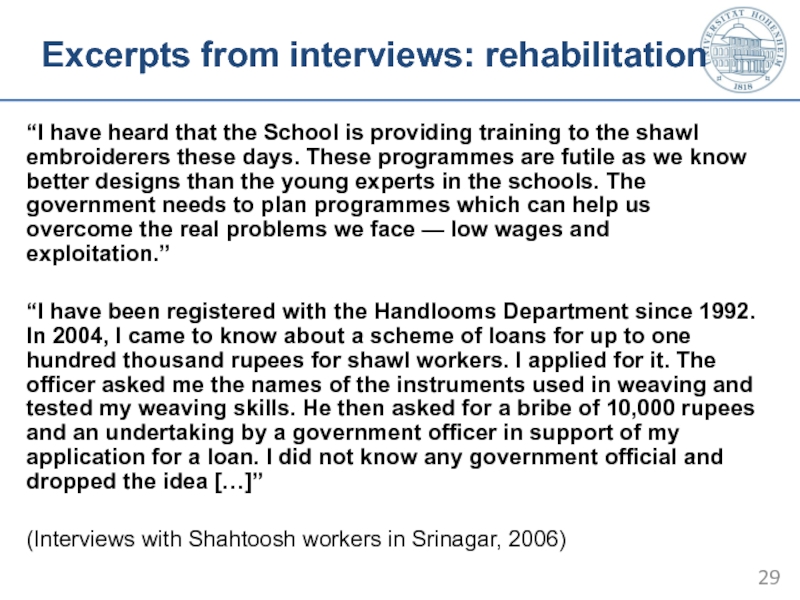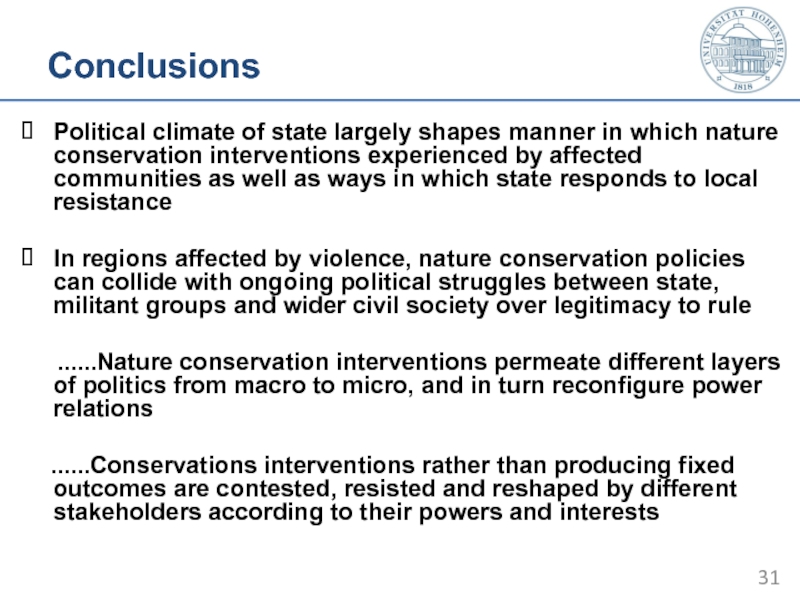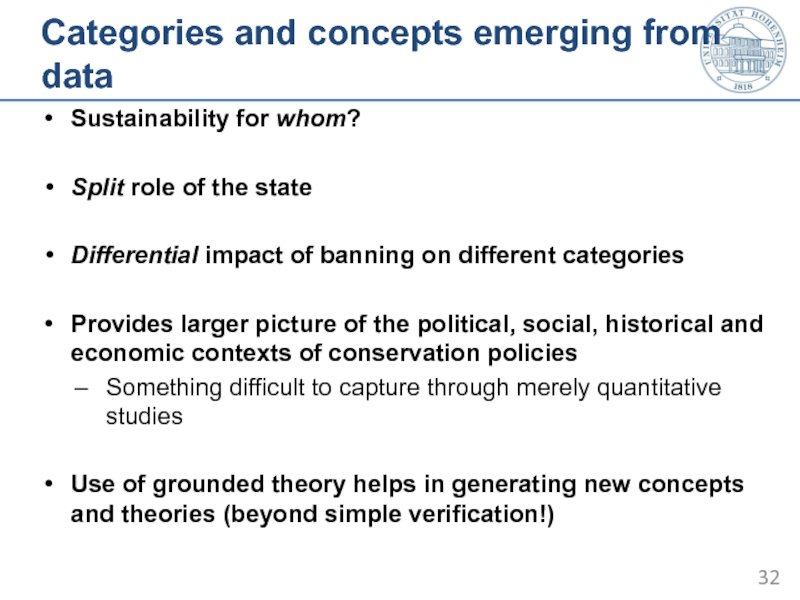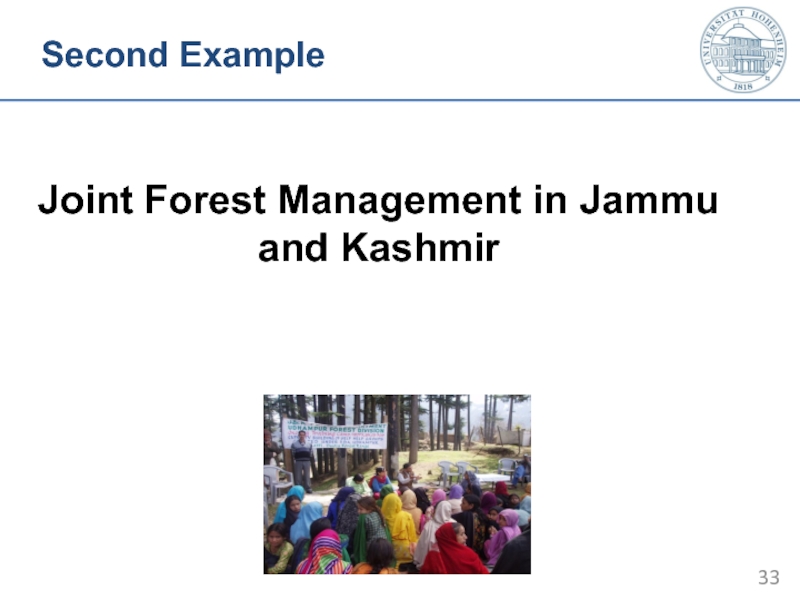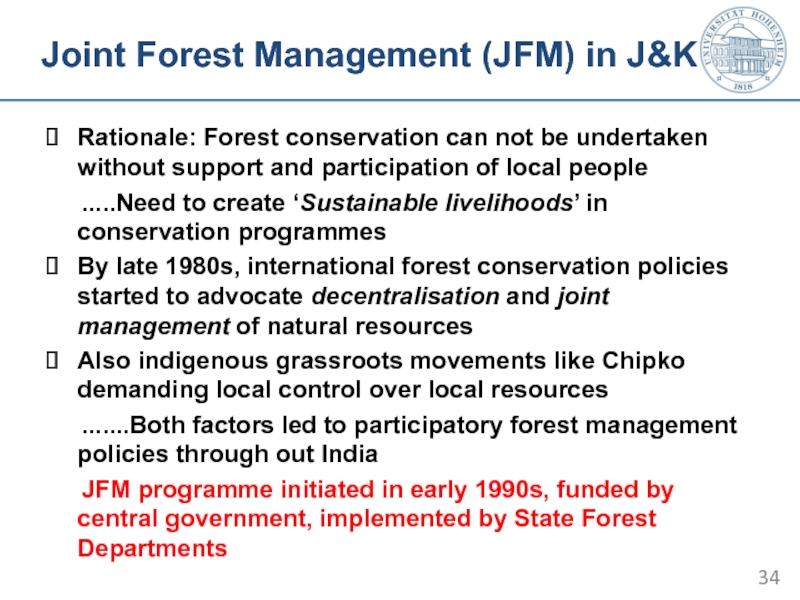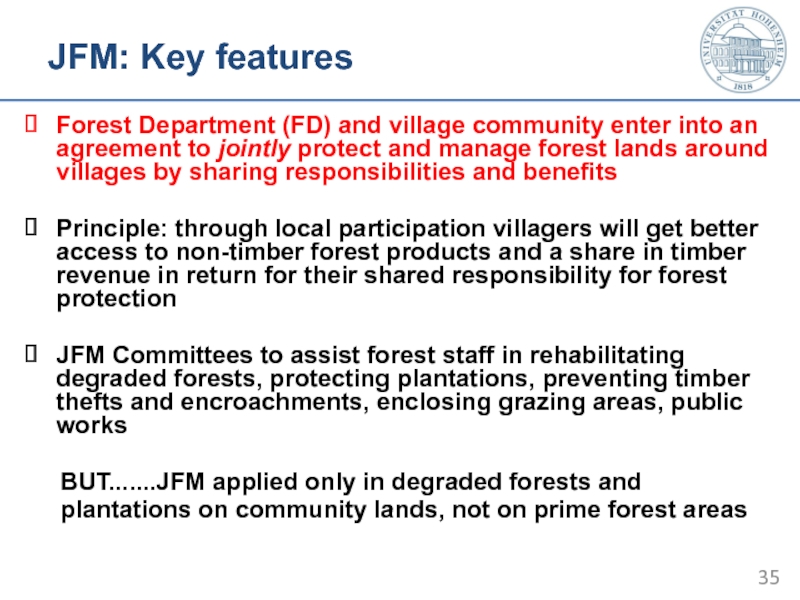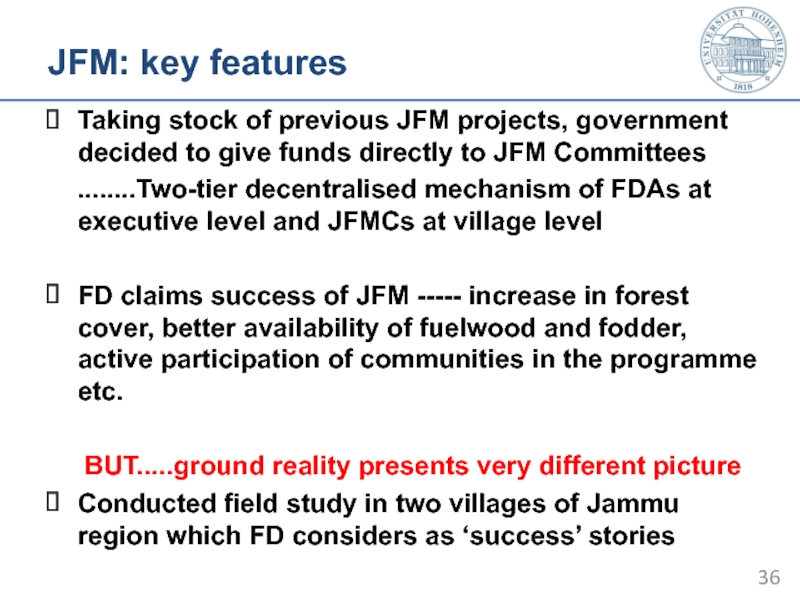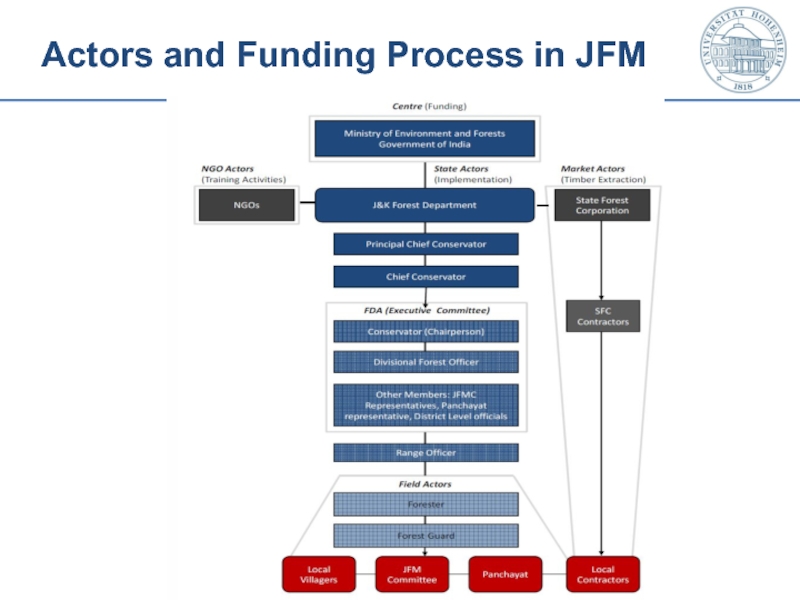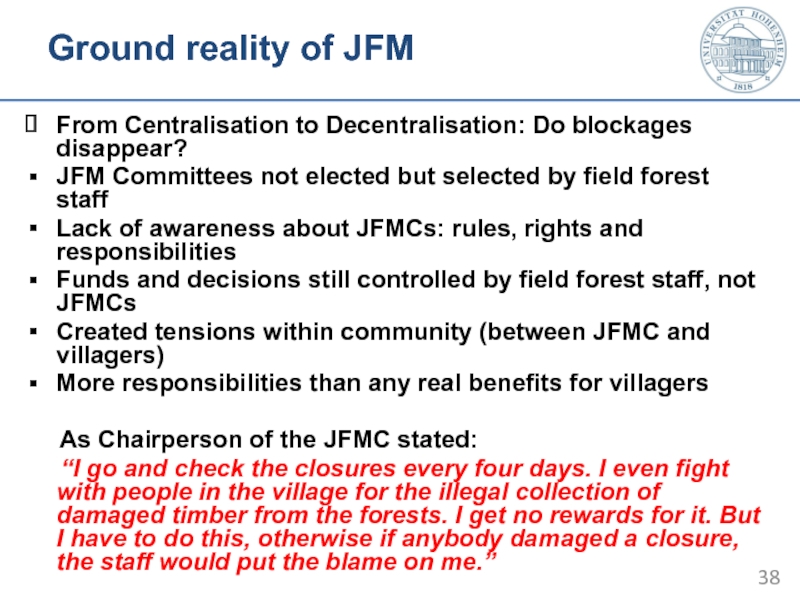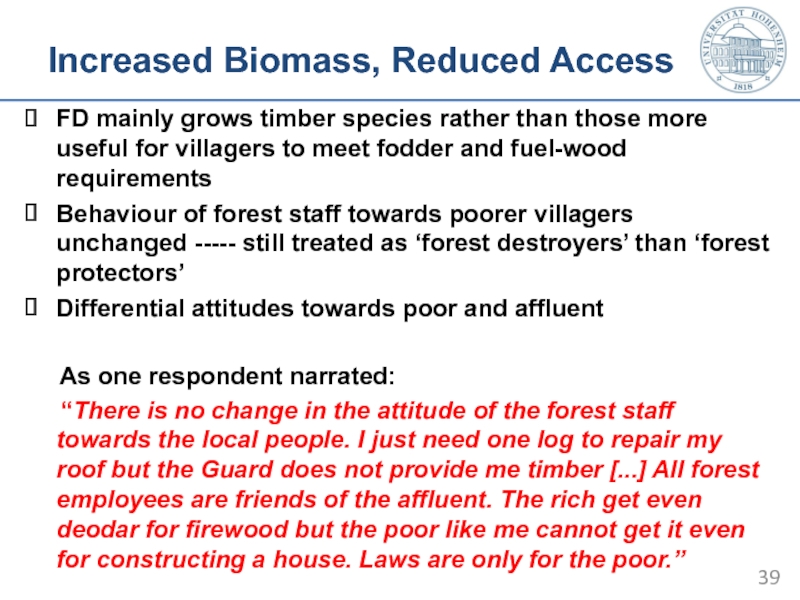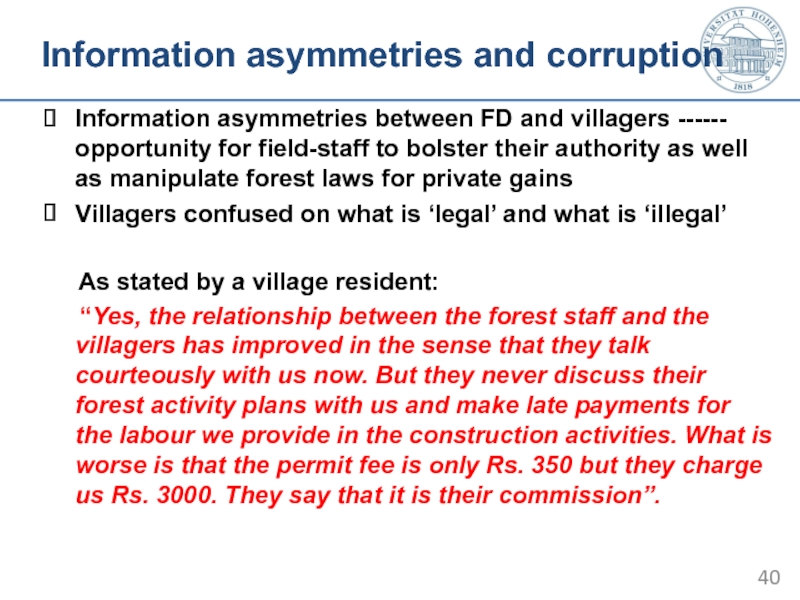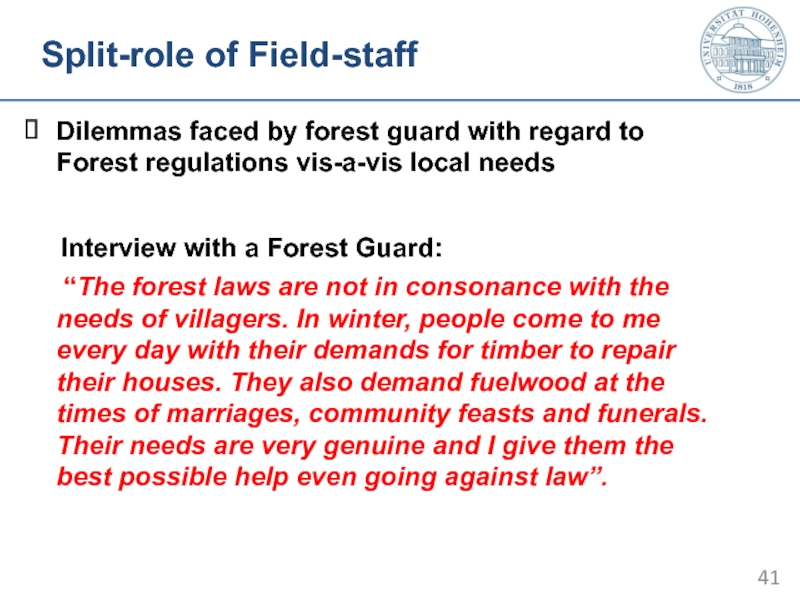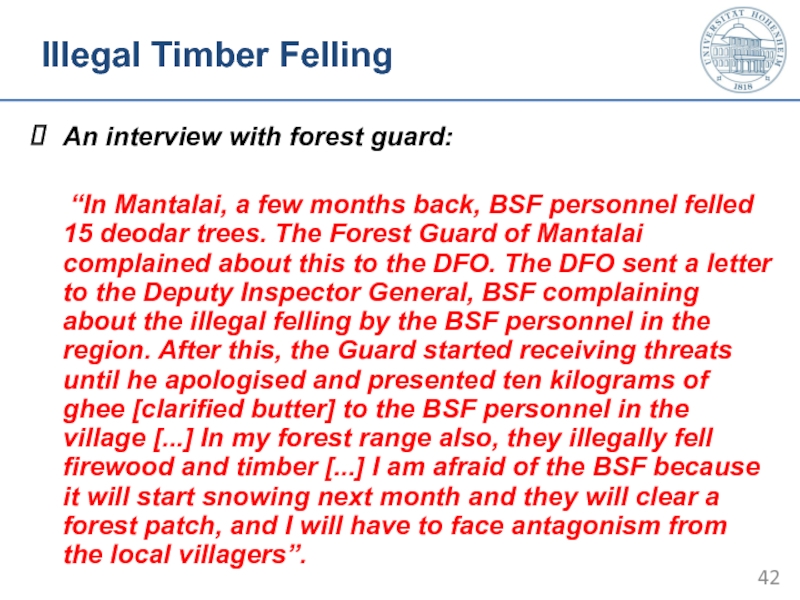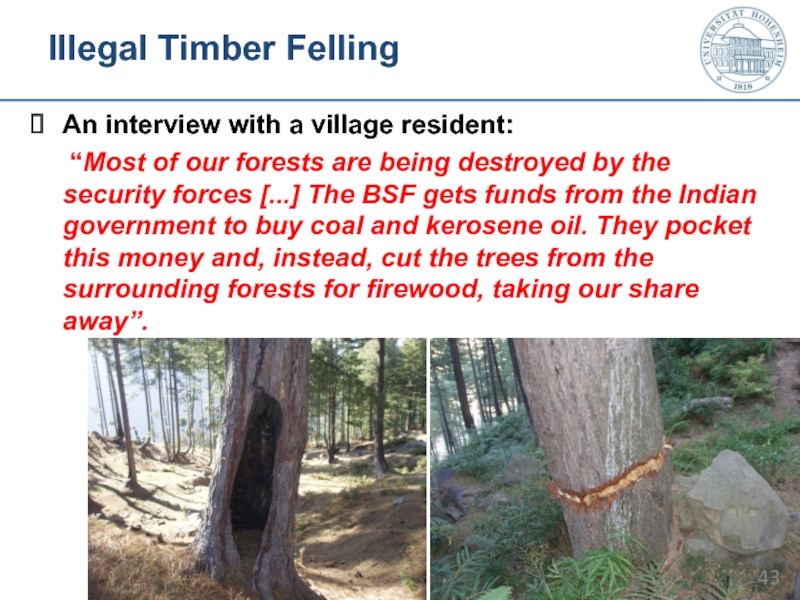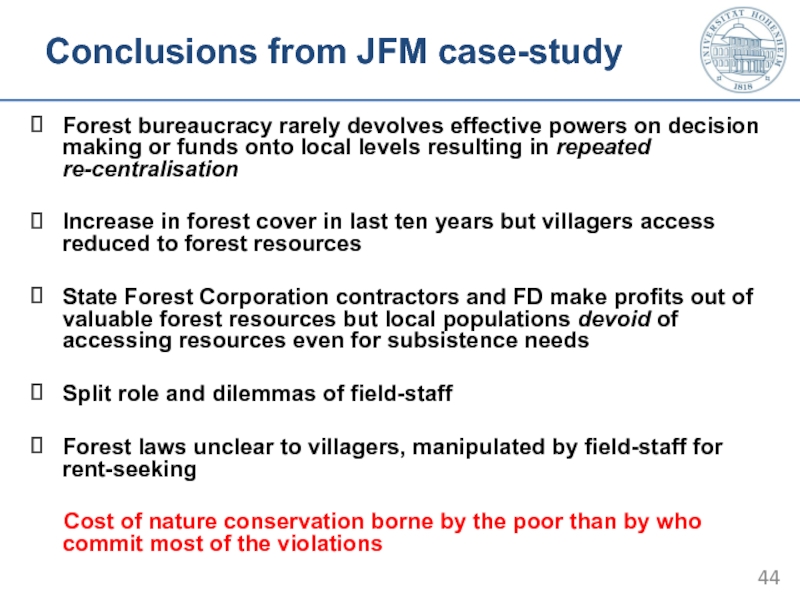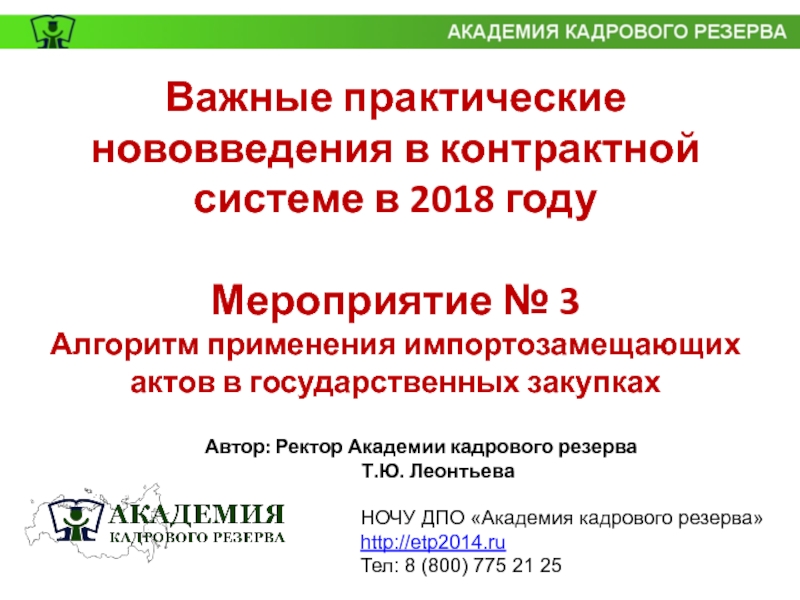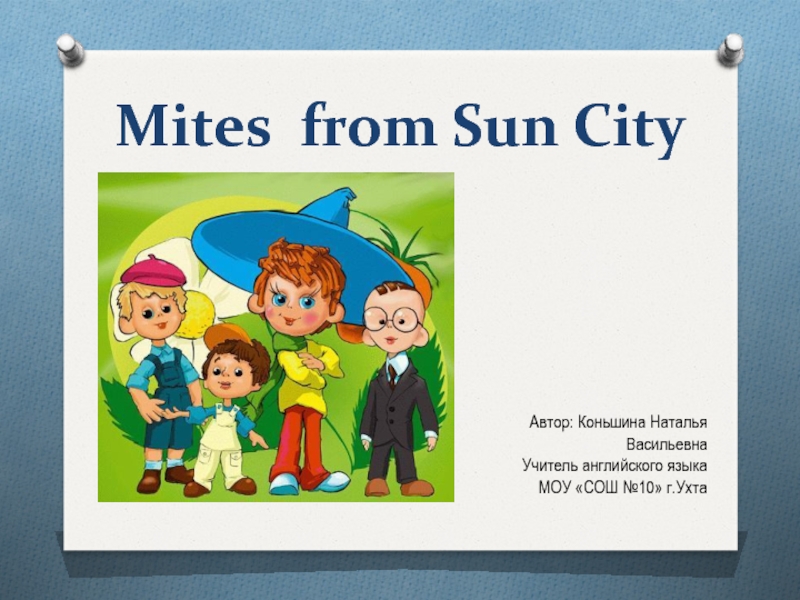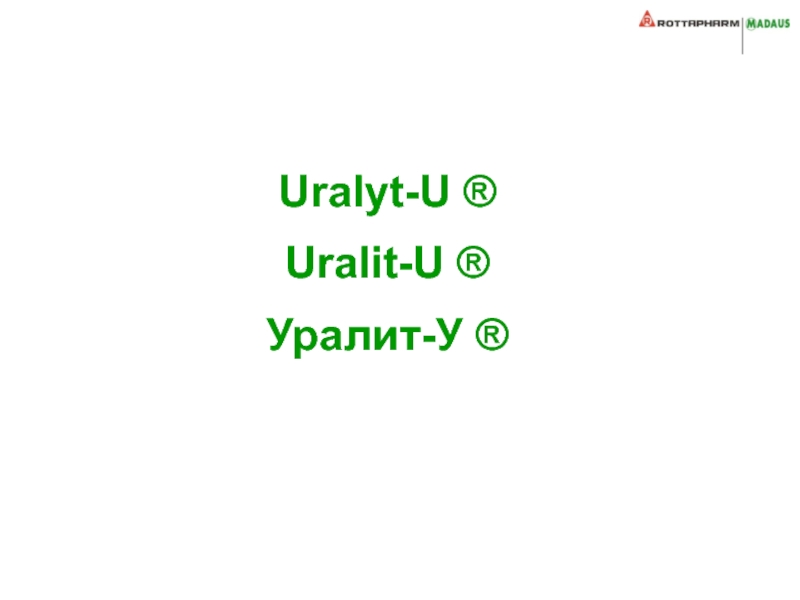Birner
Dr. Saurabh Gupta
Social and Institutional Change in Agricultural Development (490C)
- Главная
- Разное
- Дизайн
- Бизнес и предпринимательство
- Аналитика
- Образование
- Развлечения
- Красота и здоровье
- Финансы
- Государство
- Путешествия
- Спорт
- Недвижимость
- Армия
- Графика
- Культурология
- Еда и кулинария
- Лингвистика
- Английский язык
- Астрономия
- Алгебра
- Биология
- География
- Детские презентации
- Информатика
- История
- Литература
- Маркетинг
- Математика
- Медицина
- Менеджмент
- Музыка
- МХК
- Немецкий язык
- ОБЖ
- Обществознание
- Окружающий мир
- Педагогика
- Русский язык
- Технология
- Физика
- Философия
- Химия
- Шаблоны, картинки для презентаций
- Экология
- Экономика
- Юриспруденция
Lecture 1. Qualitative Research Methods in Rural Development Studies (4903-470). Practical Examples презентация
Содержание
- 1. Lecture 1. Qualitative Research Methods in Rural Development Studies (4903-470). Practical Examples
- 2. Introduction A little exercise in interviewing Please
- 3. Qualitative and Quantitative Research “There's no
- 4. Quantitative and Qualitative „In many social sciences,
- 5. Some aspects of Qualitative Research Qualitative research
- 6. Some misperceptions about qualitative research Misperceptions
- 7. What are the learning goals of this module?
- 8. Learning goals of this module This module
- 9. Qualitative Research in Practice
- 10. Wildlife and Forest Conservation in J&K
- 11. Case of Tibetan Antelope (Chiru) Chiru endemic
- 12. Production Process of Shawls Source: Saloni Gupta, 2011
- 13. Trade routes of shahtoosh wool
- 14. Pictures from fieldwork De-hairing Machine Spinner Warp Threaders Warp Dressers
- 15. Issues in banning of shahtoosh Prevalence of
- 16. Some questions for discussion... The research objective
- 17. Data collection Historical records, travellers accounts, archives
- 18. Description of fieldwork period Stage 1: Building
- 19. Description of fieldwork period Stage 2: Interviews
- 20. History of Shawl Industry Origin of shawl
- 21. Legal Status of Chiru Listed in Appendix
- 22. Ban on Shahtoosh: chronology of events
- 23. Split role of the state? Party
- 24. Excerpts from interviews: politics of banning
- 25. Perpetuation of myths post-ban Excerpts from interviews:
- 26. Differential Impact of Ban Different
- 27. Excerpts from interviews: Differential Impact of Ban
- 28. ‘Delegated Illegality’ Poverty and lack of alternative
- 29. Excerpts from interviews: rehabilitation “I have heard
- 30. Conclusions Global concern for wildlife conservation is
- 31. Conclusions Political climate of state largely
- 32. Categories and concepts emerging from data Sustainability
- 33. Second Example Joint Forest Management in Jammu and Kashmir
- 34. Joint Forest Management (JFM) in J&K Rationale:
- 35. JFM: Key features Forest Department (FD) and
- 36. JFM: key features Taking stock of previous
- 37. Actors and Funding Process in JFM
- 38. Ground reality of JFM From Centralisation to
- 39. Increased Biomass, Reduced Access FD mainly grows
- 40. Information asymmetries and corruption Information asymmetries between
- 41. Split-role of Field-staff Dilemmas faced by forest
- 42. Illegal Timber Felling An interview with forest
- 43. Illegal Timber Felling An interview with a
- 44. Conclusions from JFM case-study Forest bureaucracy rarely
Слайд 1Qualitative Research Methods in Rural Development Studies (4903-470) 2014-15 Prof. Dr. Regina
Слайд 2Introduction
A little exercise in interviewing
Please interview your neighbour about the issues,
and then introduce him/her to the class – and vice versa
1. What is your name?
2. Where were you born, and where did you grow up?
3. Where and what did you study before coming to Hohenheim?
4. What are your career goals?
5. Why are you interested in learning about qualitative research methods?
• What do you expect from this course?
• How is this course linked to your career goals?
6. Do you have any experience in working and/or conducting research in a developing country? If yes, could you please share some information about it.
1. What is your name?
2. Where were you born, and where did you grow up?
3. Where and what did you study before coming to Hohenheim?
4. What are your career goals?
5. Why are you interested in learning about qualitative research methods?
• What do you expect from this course?
• How is this course linked to your career goals?
6. Do you have any experience in working and/or conducting research in a developing country? If yes, could you please share some information about it.
Слайд 3Qualitative and Quantitative Research
“There's no such thing as qualitative data. Everything
is either 1 or 0”
- Fred Kerlinger
“All research ultimately has a qualitative grounding”
- Donald Campbell
Source: Miles & Huberman (1994, p. 40) Qualitative Data Analysis
- Fred Kerlinger
“All research ultimately has a qualitative grounding”
- Donald Campbell
Source: Miles & Huberman (1994, p. 40) Qualitative Data Analysis
3
Слайд 4Quantitative and Qualitative
„In many social sciences, quantitative orientations are often given
more respect. This may reflect the tendency of the general public to regard science as relating to numbers and implying precision.“ (Berg, 2009)
Quantity: essentially an amount of something
Quality: elementally the nature of things- the what, how, when, and where of things
Qualitative research refers to the meanings, concepts, characteristics or descriptions of things.
Quantity: essentially an amount of something
Quality: elementally the nature of things- the what, how, when, and where of things
Qualitative research refers to the meanings, concepts, characteristics or descriptions of things.
Слайд 5Some aspects of Qualitative Research
Qualitative research is concerned with developing explanations
of social phenomena. It aims to help us to understand the world in which we live and why things are the way they are.
It is concerned with the social aspects of our world and seeks to answer questions about:
Why people behave the way they do
How opinions and attitudes are formed
How people are affected by the events that go on around them
How and why cultures have developed in the way they have
The differences between social groups
Questions which begin with: why? how? in what way? And not generally how much, how many and to what extent?
It is concerned with the social aspects of our world and seeks to answer questions about:
Why people behave the way they do
How opinions and attitudes are formed
How people are affected by the events that go on around them
How and why cultures have developed in the way they have
The differences between social groups
Questions which begin with: why? how? in what way? And not generally how much, how many and to what extent?
Слайд 6Some misperceptions about qualitative research
Misperceptions
Qualitative research means you just interview
people.
Qualitative research is less rigorous than quantitative research.
Doing qualitative research does not require specific training, everyone can do it.
Qualitative research requires less preparation than quantitative research.
In reality
Qualitative research requires different skills from quantitative research.
Qualitative research requires as much preparation as quantitative research.
Documenting qualitative findings, analyzing them and writing them up is as challenging as analyzing quantitative data.
Qualitative research is less rigorous than quantitative research.
Doing qualitative research does not require specific training, everyone can do it.
Qualitative research requires less preparation than quantitative research.
In reality
Qualitative research requires different skills from quantitative research.
Qualitative research requires as much preparation as quantitative research.
Documenting qualitative findings, analyzing them and writing them up is as challenging as analyzing quantitative data.
Слайд 8Learning goals of this module
This module aims to enable you to
understand
the theoretical foundations of qualitative research methods;
be familiar with a range qualitative, including participatory, research methods that can be used for different purposes (academic research, project management, advocacy);
plan research projects that are based on qualitative research methods and identify the research methods that are most suited for a given purpose;
collect empirical data using selected qualitative research methods;
analyze data that have been collected using these qualitative methods; and
Draw conclusions and policy implications from qualitative research.
be familiar with a range qualitative, including participatory, research methods that can be used for different purposes (academic research, project management, advocacy);
plan research projects that are based on qualitative research methods and identify the research methods that are most suited for a given purpose;
collect empirical data using selected qualitative research methods;
analyze data that have been collected using these qualitative methods; and
Draw conclusions and policy implications from qualitative research.
Слайд 9Qualitative Research in Practice
Case of wildlife conservation in Jammu and Kashmir,
India
Doctoral Research by Ms. Saloni Gupta, University of London, 2011
Doctoral Research by Ms. Saloni Gupta, University of London, 2011
Слайд 10Wildlife and Forest Conservation in J&K
Source: Saloni Gupta, 2011 (PhD Thesis,
University of London)
Слайд 11Case of Tibetan Antelope (Chiru)
Chiru endemic to Tibetan high plains
Wool (known
as shahtoosh) derived from the underskin
Weaving done exclusively in Kashmir; age old industry
Huge demand in high-end fashion markets of the world
Price range 1000-10000 Euro per shawl; employs 20000 people
International ban implemented in 2002
Weaving done exclusively in Kashmir; age old industry
Huge demand in high-end fashion markets of the world
Price range 1000-10000 Euro per shawl; employs 20000 people
International ban implemented in 2002
Слайд 15Issues in banning of shahtoosh
Prevalence of myths regarding the origin of
the wool
Trade made “illegal“ in India since 1986 but J&K has its seperate constitution
First scientific evidence on the connection between shahtoosh and killing of chiru in 1992
International pressure on the Indian government since mid 1990s; role of conservation NGOs (WPSI, IFAW)
Long legal battle in the J&K High Court and Supreme Court
Decision to ban trade in 2002; massive unemployment issue
Shawl traders and manufacturers resisted the ban; poor workers made scapegoats
False promises; No compensation or rehabilitation
Trade continues illegally; workers further marginalised
What after antelope population rises?
Trade made “illegal“ in India since 1986 but J&K has its seperate constitution
First scientific evidence on the connection between shahtoosh and killing of chiru in 1992
International pressure on the Indian government since mid 1990s; role of conservation NGOs (WPSI, IFAW)
Long legal battle in the J&K High Court and Supreme Court
Decision to ban trade in 2002; massive unemployment issue
Shawl traders and manufacturers resisted the ban; poor workers made scapegoats
False promises; No compensation or rehabilitation
Trade continues illegally; workers further marginalised
What after antelope population rises?
Слайд 16Some questions for discussion...
The research objective is to understand the process
of banning of Shahtoosh, its impact on the livelihoods of dependent communities, and percpetions of different actors involved.
What are the limitations and prospects of exploring this issue with the help of quantitative data?
Is qualitative research more suitable to understand processes and politics of resource conservation ?
How could one make use of qualitative research methods in this case?
What are the limitations and prospects of exploring this issue with the help of quantitative data?
Is qualitative research more suitable to understand processes and politics of resource conservation ?
How could one make use of qualitative research methods in this case?
Слайд 17Data collection
Historical records, travellers accounts, archives etc
Reports produced by wildlife conservation
agencies
Proceedings of the High Court and Supreme Court (documents relating to legal battle)
Fact finding mission reports and other government records
Interviews with various stake holders:
schedules with open ended questions, semi-structured interviews, focus groups, informal conversations and observation
Purposive and Snowball sampling
interviewed a total of 117 respondents - 92 shahtoosh workers; 16 government officials; 7 conservationists and 2 politicians
Proceedings of the High Court and Supreme Court (documents relating to legal battle)
Fact finding mission reports and other government records
Interviews with various stake holders:
schedules with open ended questions, semi-structured interviews, focus groups, informal conversations and observation
Purposive and Snowball sampling
interviewed a total of 117 respondents - 92 shahtoosh workers; 16 government officials; 7 conservationists and 2 politicians
Слайд 18Description of fieldwork period
Stage 1: Building up contacts, personal setup and
initial interviews with workers
Finding a safe place to stay
Interpreter and/or research assistant
Preliminary information from reports produced by wildlife organisations
Mapping out categories localities of workers
Preliminary interviews with key informants- senior members of workers community
Preperation of questions and schedules for next round of interviews with workers
Information about protest, resistance and illegal trade emerged during this stage
Finding a safe place to stay
Interpreter and/or research assistant
Preliminary information from reports produced by wildlife organisations
Mapping out categories localities of workers
Preliminary interviews with key informants- senior members of workers community
Preperation of questions and schedules for next round of interviews with workers
Information about protest, resistance and illegal trade emerged during this stage
Слайд 19Description of fieldwork period
Stage 2: Interviews with state actors and local
NGOs
Understanding the ´´split´´ role of the state in enforcing the ban and allowing the trade to continue
Interviews with local NGOs and state actors on rehabilitation
Conflicts between the state and NGO actors
Stage 3: Interviews with central government officials and national NGOs
Insights into the legal battle between the centre, state and conservationist groups
Efforts towards rehabiliation or compensation
Status of illegal trade after the ban
Understanding the ´´split´´ role of the state in enforcing the ban and allowing the trade to continue
Interviews with local NGOs and state actors on rehabilitation
Conflicts between the state and NGO actors
Stage 3: Interviews with central government officials and national NGOs
Insights into the legal battle between the centre, state and conservationist groups
Efforts towards rehabiliation or compensation
Status of illegal trade after the ban
Слайд 20History of Shawl Industry
Origin of shawl industry (14th century)
State owned workshops
(karkhanas) developed under the Mughals (16th century)
Shawl revenue more than land revenue during Afghan rule (18th century)
Expansion of shawl markets and trade with Europe (19th century)
Complex division of labour; brokers became powerful
Heavy taxation on poor shawl workers continued until independence
Working conditions improved a bit in post-independence period
Industry dominated by rulers and merchants in pre-independence period was now dominated by manufacturers and traders
Shawl revenue more than land revenue during Afghan rule (18th century)
Expansion of shawl markets and trade with Europe (19th century)
Complex division of labour; brokers became powerful
Heavy taxation on poor shawl workers continued until independence
Working conditions improved a bit in post-independence period
Industry dominated by rulers and merchants in pre-independence period was now dominated by manufacturers and traders
Слайд 21Legal Status of Chiru
Listed in Appendix 1 of CITES, making trade
illegal
Listed as “endangered” in the IUCN Red List of Threatened Animals
In India, protected under the Wildlife Act 1977; permitted trade under license
Completely banned in India in 1986
J&K has its separate wildlife protection act
Under J&K Wildlife Act 1978, listed in schedule II; permitted trade under license
Trade continued in spite of international ban
Legally banned in J&K in 2002
Listed as “endangered” in the IUCN Red List of Threatened Animals
In India, protected under the Wildlife Act 1977; permitted trade under license
Completely banned in India in 1986
J&K has its separate wildlife protection act
Under J&K Wildlife Act 1978, listed in schedule II; permitted trade under license
Trade continued in spite of international ban
Legally banned in J&K in 2002
Слайд 22Ban on Shahtoosh: chronology of events
Late 1980s: CITES and wildlife
conservation NGOs began creating awareness about shahtoosh and antelope
No awareness programmes in J&K; only in metropolitan cities
1995: CITES accused Indian MoEF of failing to stop the trade
Survey team of MoEF to study chiru habitat, and market demand; found chiru farming as not a viable option
Wildlife Warden of Leh stated that captive breeding is possible but requires high investment costs
1997: Wildlife Protection Society of India (WPSI) requested the J&K state to stop the trade as it is illegal according to international laws
No awareness programmes in J&K; only in metropolitan cities
1995: CITES accused Indian MoEF of failing to stop the trade
Survey team of MoEF to study chiru habitat, and market demand; found chiru farming as not a viable option
Wildlife Warden of Leh stated that captive breeding is possible but requires high investment costs
1997: Wildlife Protection Society of India (WPSI) requested the J&K state to stop the trade as it is illegal according to international laws
Слайд 23Split role of the state?
Party politics being played by two
important political outfits in Kashmir (National Conference and People’s Democratic Party)
‘Split role’ played by the J&K state; acting as an agency for imposing the ban and at the same time allowing illegal production and trade to continue
Out of 92 shahtoosh workers interviewed, 24 still engaged in shahtoosh
Manufacturers have strong links with politicians and police; poorer workers often harassed by officials
No seizures of shahtoosh in Kashmir; only confiscated outside J&K and abroad
Rent seeking opportunities for local officials
‘Split role’ played by the J&K state; acting as an agency for imposing the ban and at the same time allowing illegal production and trade to continue
Out of 92 shahtoosh workers interviewed, 24 still engaged in shahtoosh
Manufacturers have strong links with politicians and police; poorer workers often harassed by officials
No seizures of shahtoosh in Kashmir; only confiscated outside J&K and abroad
Rent seeking opportunities for local officials
Слайд 24Excerpts from interviews: politics of banning
“As long as I am
the Chief Minister, shahtoosh will be sold in Kashmir. The campaign to ban the trade maligns the people of the state […] There was no evidence of Tibetan antelope being reduced in number or their being shot to acquire wool for shahtoosh”
(CM of J&K, 28 June, 1998)
“Why target us? Why not raid the houses of ministers, bureaucrats and rich people? We've supplied shahtoosh shawls to most of them”
(A poor shawl hawker, 6 Nov 2006)
“We are harassed by the police. We pay several thousand rupees at different check posts until we reach Delhi. Many a time, they keep the money as well as our shawls. The Delhi police calls us notorious militants and anti-India people […] You can imagine what will happen to us after protests and agitations”
(Shawl hawker, 2 Nov 2006)
(CM of J&K, 28 June, 1998)
“Why target us? Why not raid the houses of ministers, bureaucrats and rich people? We've supplied shahtoosh shawls to most of them”
(A poor shawl hawker, 6 Nov 2006)
“We are harassed by the police. We pay several thousand rupees at different check posts until we reach Delhi. Many a time, they keep the money as well as our shawls. The Delhi police calls us notorious militants and anti-India people […] You can imagine what will happen to us after protests and agitations”
(Shawl hawker, 2 Nov 2006)
Слайд 25Perpetuation of myths post-ban
Excerpts from interviews:
“Ban on shahtoosh is not justifiable
as it based on the wrong reason that wool is obtained after killing an animal found in Tibet. Actually, the wool is collected by shearing goats that live on the Nepalese side and eat white mud. Had the reason behind the ban been true, I would have been the first one to support it.”
“No animal is being killed for shahtoosh wool. Had it been the case, the animals would have become extinct centuries ago. The mere fact that the supply of wool in Kashmir has increased over the last three decades confirms the fact that the animal is safe. I have heard that the animal looks like peacock”
(Interviews with Shahtoosh weavers in Srinagar, 2006)
“No animal is being killed for shahtoosh wool. Had it been the case, the animals would have become extinct centuries ago. The mere fact that the supply of wool in Kashmir has increased over the last three decades confirms the fact that the animal is safe. I have heard that the animal looks like peacock”
(Interviews with Shahtoosh weavers in Srinagar, 2006)
Слайд 26Differential Impact of Ban
Different categories of workers have experienced
differential impacts
Shahtoosh workers are left to work with pashmina wool; already a saturated sector
Separators have become jobless because dehairing of pashmina wool is possible with machines
Spinners, clippers, weavers, deisgners, darners, warp-dressers and embroiderers have lost almost two-third of their incomes
Manufacturers, wool agents and traders have devised ways to compensate their losses
Artificial shortages of wool, reaching out to rural artisans, use of machines, adulteration of wool and yarn, and deducting wages of poorer workers on the pretext of illegality
Shahtoosh workers are left to work with pashmina wool; already a saturated sector
Separators have become jobless because dehairing of pashmina wool is possible with machines
Spinners, clippers, weavers, deisgners, darners, warp-dressers and embroiderers have lost almost two-third of their incomes
Manufacturers, wool agents and traders have devised ways to compensate their losses
Artificial shortages of wool, reaching out to rural artisans, use of machines, adulteration of wool and yarn, and deducting wages of poorer workers on the pretext of illegality
Слайд 27Excerpts from interviews: Differential Impact of Ban
“Before the ban,
I was respected in my locality. People used to greet me as salaam sahib owing to my prosperity but after the ban, we are struggling even to bear the daily household expenses. The other name for our life now is compromise as we practically experience it at every step [...] These days, even a wage-labourer earns more than we do”
(Interview with a weaver, Srinagar)
“I used to clean 200 grams of shahtoosh per day and earned Rs. 250 for it. Although I did not receive this amount of wool everyday, my monthly income with shahtoosh was Rs. 1000 per month [before the ban]. With this income, I supported my family by contributing to the household expenses. After the ban, I get no wool to clean and the job of dehairing pashmina has also now been taken over by machines.”
(Interview with a separator, Srinagar)
(Interview with a weaver, Srinagar)
“I used to clean 200 grams of shahtoosh per day and earned Rs. 250 for it. Although I did not receive this amount of wool everyday, my monthly income with shahtoosh was Rs. 1000 per month [before the ban]. With this income, I supported my family by contributing to the household expenses. After the ban, I get no wool to clean and the job of dehairing pashmina has also now been taken over by machines.”
(Interview with a separator, Srinagar)
Слайд 28‘Delegated Illegality’
Poverty and lack of alternative employment opportunities are not the
only determining factors for the participation of poor workers in the now illegal trade
The workers are controlled by manufacturers and wool agents who delegate illegal tasks to them
No concrete measures were taken by the government and conservation NGOs for rehabilitation, nor any compensation paid.
Whatever discrete initiatives were taken, they failed to address their primary concerns
The workers are controlled by manufacturers and wool agents who delegate illegal tasks to them
No concrete measures were taken by the government and conservation NGOs for rehabilitation, nor any compensation paid.
Whatever discrete initiatives were taken, they failed to address their primary concerns
Слайд 29Excerpts from interviews: rehabilitation
“I have heard that the School is providing
training to the shawl embroiderers these days. These programmes are futile as we know better designs than the young experts in the schools. The government needs to plan programmes which can help us overcome the real problems we face — low wages and exploitation.”
“I have been registered with the Handlooms Department since 1992. In 2004, I came to know about a scheme of loans for up to one hundred thousand rupees for shawl workers. I applied for it. The officer asked me the names of the instruments used in weaving and tested my weaving skills. He then asked for a bribe of 10,000 rupees and an undertaking by a government officer in support of my application for a loan. I did not know any government official and dropped the idea […]”
(Interviews with Shahtoosh workers in Srinagar, 2006)
“I have been registered with the Handlooms Department since 1992. In 2004, I came to know about a scheme of loans for up to one hundred thousand rupees for shawl workers. I applied for it. The officer asked me the names of the instruments used in weaving and tested my weaving skills. He then asked for a bribe of 10,000 rupees and an undertaking by a government officer in support of my application for a loan. I did not know any government official and dropped the idea […]”
(Interviews with Shahtoosh workers in Srinagar, 2006)
Слайд 30Conclusions
Global concern for wildlife conservation is justifiable but matching accountability towards
affected communities is missing
.....Blanket ban without rehabilitation unlikely to meet goals of sustainable resource management, especially in conflict regions
Shrunken space for protest in Kashmir crucial to sidelining issues of alternative livelihoods of affected populations
Kashmiri shawl hawkers often face harassment from police agencies outside state, seen as suspected terrorists
Powerful actors are able to manipulate the laws and minimise losses, the poor pay the cost of conservation
.....Blanket ban without rehabilitation unlikely to meet goals of sustainable resource management, especially in conflict regions
Shrunken space for protest in Kashmir crucial to sidelining issues of alternative livelihoods of affected populations
Kashmiri shawl hawkers often face harassment from police agencies outside state, seen as suspected terrorists
Powerful actors are able to manipulate the laws and minimise losses, the poor pay the cost of conservation
Слайд 31Conclusions
Political climate of state largely shapes manner in which nature conservation
interventions experienced by affected communities as well as ways in which state responds to local resistance
In regions affected by violence, nature conservation policies can collide with ongoing political struggles between state, militant groups and wider civil society over legitimacy to rule
......Nature conservation interventions permeate different layers of politics from macro to micro, and in turn reconfigure power relations
......Conservations interventions rather than producing fixed outcomes are contested, resisted and reshaped by different stakeholders according to their powers and interests
In regions affected by violence, nature conservation policies can collide with ongoing political struggles between state, militant groups and wider civil society over legitimacy to rule
......Nature conservation interventions permeate different layers of politics from macro to micro, and in turn reconfigure power relations
......Conservations interventions rather than producing fixed outcomes are contested, resisted and reshaped by different stakeholders according to their powers and interests
Слайд 32Categories and concepts emerging from data
Sustainability for whom?
Split role of the
state
Differential impact of banning on different categories
Provides larger picture of the political, social, historical and economic contexts of conservation policies
Something difficult to capture through merely quantitative studies
Use of grounded theory helps in generating new concepts and theories (beyond simple verification!)
Differential impact of banning on different categories
Provides larger picture of the political, social, historical and economic contexts of conservation policies
Something difficult to capture through merely quantitative studies
Use of grounded theory helps in generating new concepts and theories (beyond simple verification!)
Слайд 34Joint Forest Management (JFM) in J&K
Rationale: Forest conservation can not be
undertaken without support and participation of local people
.....Need to create ‘Sustainable livelihoods’ in conservation programmes
By late 1980s, international forest conservation policies started to advocate decentralisation and joint management of natural resources
Also indigenous grassroots movements like Chipko demanding local control over local resources
.......Both factors led to participatory forest management policies through out India
JFM programme initiated in early 1990s, funded by central government, implemented by State Forest Departments
.....Need to create ‘Sustainable livelihoods’ in conservation programmes
By late 1980s, international forest conservation policies started to advocate decentralisation and joint management of natural resources
Also indigenous grassroots movements like Chipko demanding local control over local resources
.......Both factors led to participatory forest management policies through out India
JFM programme initiated in early 1990s, funded by central government, implemented by State Forest Departments
Слайд 35JFM: Key features
Forest Department (FD) and village community enter into an
agreement to jointly protect and manage forest lands around villages by sharing responsibilities and benefits
Principle: through local participation villagers will get better access to non-timber forest products and a share in timber revenue in return for their shared responsibility for forest protection
JFM Committees to assist forest staff in rehabilitating degraded forests, protecting plantations, preventing timber thefts and encroachments, enclosing grazing areas, public works
BUT.......JFM applied only in degraded forests and
plantations on community lands, not on prime forest areas
Principle: through local participation villagers will get better access to non-timber forest products and a share in timber revenue in return for their shared responsibility for forest protection
JFM Committees to assist forest staff in rehabilitating degraded forests, protecting plantations, preventing timber thefts and encroachments, enclosing grazing areas, public works
BUT.......JFM applied only in degraded forests and
plantations on community lands, not on prime forest areas
Слайд 36JFM: key features
Taking stock of previous JFM projects, government decided to
give funds directly to JFM Committees
........Two-tier decentralised mechanism of FDAs at executive level and JFMCs at village level
FD claims success of JFM ----- increase in forest cover, better availability of fuelwood and fodder, active participation of communities in the programme etc.
BUT.....ground reality presents very different picture
Conducted field study in two villages of Jammu region which FD considers as ‘success’ stories
........Two-tier decentralised mechanism of FDAs at executive level and JFMCs at village level
FD claims success of JFM ----- increase in forest cover, better availability of fuelwood and fodder, active participation of communities in the programme etc.
BUT.....ground reality presents very different picture
Conducted field study in two villages of Jammu region which FD considers as ‘success’ stories
Слайд 38Ground reality of JFM
From Centralisation to Decentralisation: Do blockages disappear?
JFM Committees
not elected but selected by field forest staff
Lack of awareness about JFMCs: rules, rights and responsibilities
Funds and decisions still controlled by field forest staff, not JFMCs
Created tensions within community (between JFMC and villagers)
More responsibilities than any real benefits for villagers
As Chairperson of the JFMC stated:
“I go and check the closures every four days. I even fight with people in the village for the illegal collection of damaged timber from the forests. I get no rewards for it. But I have to do this, otherwise if anybody damaged a closure, the staff would put the blame on me.”
Lack of awareness about JFMCs: rules, rights and responsibilities
Funds and decisions still controlled by field forest staff, not JFMCs
Created tensions within community (between JFMC and villagers)
More responsibilities than any real benefits for villagers
As Chairperson of the JFMC stated:
“I go and check the closures every four days. I even fight with people in the village for the illegal collection of damaged timber from the forests. I get no rewards for it. But I have to do this, otherwise if anybody damaged a closure, the staff would put the blame on me.”
Слайд 39Increased Biomass, Reduced Access
FD mainly grows timber species rather than those
more useful for villagers to meet fodder and fuel-wood requirements
Behaviour of forest staff towards poorer villagers unchanged ----- still treated as ‘forest destroyers’ than ‘forest protectors’
Differential attitudes towards poor and affluent
As one respondent narrated:
“There is no change in the attitude of the forest staff towards the local people. I just need one log to repair my roof but the Guard does not provide me timber [...] All forest employees are friends of the affluent. The rich get even deodar for firewood but the poor like me cannot get it even for constructing a house. Laws are only for the poor.”
Behaviour of forest staff towards poorer villagers unchanged ----- still treated as ‘forest destroyers’ than ‘forest protectors’
Differential attitudes towards poor and affluent
As one respondent narrated:
“There is no change in the attitude of the forest staff towards the local people. I just need one log to repair my roof but the Guard does not provide me timber [...] All forest employees are friends of the affluent. The rich get even deodar for firewood but the poor like me cannot get it even for constructing a house. Laws are only for the poor.”
Слайд 40Information asymmetries and corruption
Information asymmetries between FD and villagers ------ opportunity
for field-staff to bolster their authority as well as manipulate forest laws for private gains
Villagers confused on what is ‘legal’ and what is ‘illegal’
As stated by a village resident:
“Yes, the relationship between the forest staff and the villagers has improved in the sense that they talk courteously with us now. But they never discuss their forest activity plans with us and make late payments for the labour we provide in the construction activities. What is worse is that the permit fee is only Rs. 350 but they charge us Rs. 3000. They say that it is their commission”.
Villagers confused on what is ‘legal’ and what is ‘illegal’
As stated by a village resident:
“Yes, the relationship between the forest staff and the villagers has improved in the sense that they talk courteously with us now. But they never discuss their forest activity plans with us and make late payments for the labour we provide in the construction activities. What is worse is that the permit fee is only Rs. 350 but they charge us Rs. 3000. They say that it is their commission”.
Слайд 41Split-role of Field-staff
Dilemmas faced by forest guard with regard to Forest
regulations vis-a-vis local needs
Interview with a Forest Guard:
“The forest laws are not in consonance with the needs of villagers. In winter, people come to me every day with their demands for timber to repair their houses. They also demand fuelwood at the times of marriages, community feasts and funerals. Their needs are very genuine and I give them the best possible help even going against law”.
Interview with a Forest Guard:
“The forest laws are not in consonance with the needs of villagers. In winter, people come to me every day with their demands for timber to repair their houses. They also demand fuelwood at the times of marriages, community feasts and funerals. Their needs are very genuine and I give them the best possible help even going against law”.
Слайд 42Illegal Timber Felling
An interview with forest guard:
“In Mantalai, a few months back, BSF personnel felled 15 deodar trees. The Forest Guard of Mantalai complained about this to the DFO. The DFO sent a letter to the Deputy Inspector General, BSF complaining about the illegal felling by the BSF personnel in the region. After this, the Guard started receiving threats until he apologised and presented ten kilograms of ghee [clarified butter] to the BSF personnel in the village [...] In my forest range also, they illegally fell firewood and timber [...] I am afraid of the BSF because it will start snowing next month and they will clear a forest patch, and I will have to face antagonism from the local villagers”.
Слайд 43Illegal Timber Felling
An interview with a village resident:
“Most
of our forests are being destroyed by the security forces [...] The BSF gets funds from the Indian government to buy coal and kerosene oil. They pocket this money and, instead, cut the trees from the surrounding forests for firewood, taking our share away”.
Слайд 44Conclusions from JFM case-study
Forest bureaucracy rarely devolves effective powers on decision
making or funds onto local levels resulting in repeated re-centralisation
Increase in forest cover in last ten years but villagers access reduced to forest resources
State Forest Corporation contractors and FD make profits out of valuable forest resources but local populations devoid of accessing resources even for subsistence needs
Split role and dilemmas of field-staff
Forest laws unclear to villagers, manipulated by field-staff for rent-seeking
Cost of nature conservation borne by the poor than by who commit most of the violations
Increase in forest cover in last ten years but villagers access reduced to forest resources
State Forest Corporation contractors and FD make profits out of valuable forest resources but local populations devoid of accessing resources even for subsistence needs
Split role and dilemmas of field-staff
Forest laws unclear to villagers, manipulated by field-staff for rent-seeking
Cost of nature conservation borne by the poor than by who commit most of the violations
